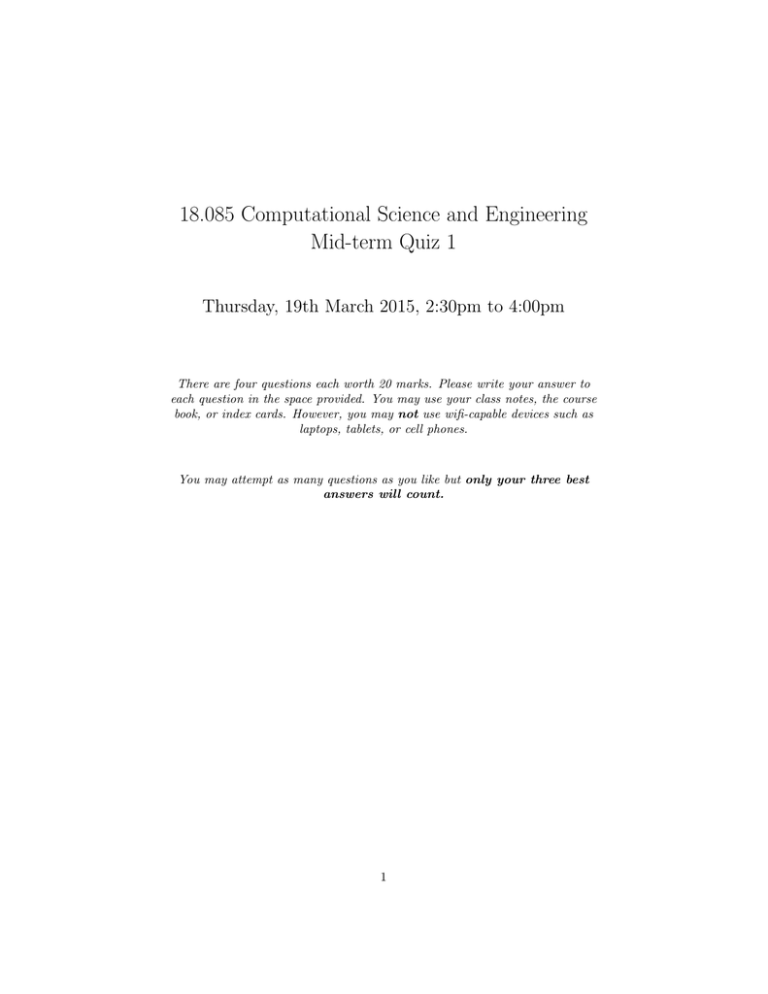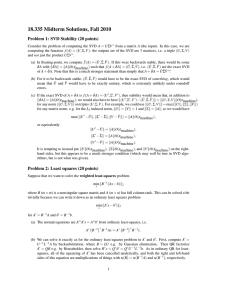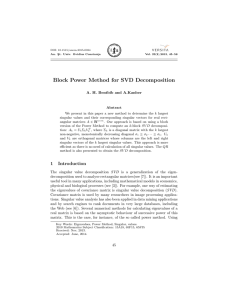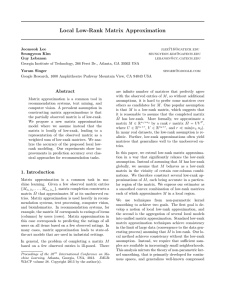18.085 Computational Science and Engineering Mid-term Quiz 1
advertisement

18.085 Computational Science and Engineering
Mid-term Quiz 1
Thursday, 19th March 2015, 2:30pm to 4:00pm
There are four questions each worth 20 marks. Please write your answer to
each question in the space provided. You may use your class notes, the course
book, or index cards. However, you may not use wifi-capable devices such as
laptops, tablets, or cell phones.
You may attempt as many questions as you like but only your three best
answers will count.
1
1. (20 marks) Here we show that the Least Squares problem can be solved
using the SVD.
By describing the structure of the matrices involved, what is the SVD of
an m × n (m > n) matrix A? What are the normal equations?
Let (−1, 2), (0, 1), and (1, 1) be data that we wish to fit a line y = c+dx to.
That is, we want to solve the following linear system in the least squares
sense:
2
1 −1 1 0 c = 1 .
d
1
1 1
| {z }
A
A factorization of the matrix A is given by
√
1
√
√1
− √12
3 √0 3
6
p
1 0
√1
2/3
0
−
.
A= 3
2
0
0 1
√1
√1
√1
0
0 | {z }
3
2
6
{z
} VT
|
{z
}|
(1)
Σ
U
Show why (1) is a SVD of A. Show that AT A = V T ΣT ΣV . Find the
best fit line, by solving AT Ax = AT b with the SVD. Calculate the least
squares error.
2
3
4
2. (20 marks) Show that
u0 (x) =
u(x + h) − u(x − h)
+ O(h2 ),
2h
where h is small. An n × n discretization of the differential equation
u0 (x) = f (x) on [0, 1] with u(0) = 0 is
0
1
2hf (h)
u(h)
−1 0
1
u(2h)
2hf (2h)
.
.
.
.
.
.
.
.
..
..
−1
,
=
.
. . 0 1 u((n − 1)h) 2hf ((n − 1)h)
hf (nh)
u(nh)
−1 1
|
{z
}
|
{z
}
b
An
where h = 1/n. Calculate the matrix R in a QR factorization of A3 . By
setting f (x) = 1, what is the solution to An v = b?
Explain how one can solve An v = b immediately by substitution, i.e.,
no elimination is required.
5
6
7
3. (20 marks) Let A be an n × n invertible matrix. Suppose A = LU and
A = QR is a LU and QR factorization of A, respectively (L, U , Q, and
R are square).
(a) Describe the structure of the matrices L, U , Q, and R. What is the
standard choice of the diagonal entries of L to make A = LU unique?
(b) Show that B = U L is similar to A.
(c) If it happens that L = Q, then explain why A must be an uppertriangular matrix.
(d) Using the fact that A = LU , give the LU factorization for AT .
(e) If A is upper-triangular then how are L and Q related? (Remember
that Q is not unique in the QR factorization.)
8
9
4. (20 marks) Consider the following system of differential equations
dx
= −3x + y,
dt
dy
= 2x − 2y,
dt
where x(0) = 1 and y(0) = 1. Writing this in matrix form, we have
dx a11 a12
x
dt
,
x(0) = 1,
y(0) = 1.
=
dy
a
a
y
21
22
dt
{z
}
|
=A
What are the values of a11 , a12 , a21 , and a22 ? By drawing the two
Gerschgorin circles, explain why the real part of the two eigenvalues of
A are not positive. From the Gerschgorin circles, can we determine if
x(t) → 0 and/or y(t) → 0 as t → ∞ (explain your answer)? By calculating det(A − xI), what are the eigenvalues of A? Calculate the eigenvectors
of A. Solve for x and y. You are told that a mistake was made and the
original system of differential equations should have been
dx
= −3.1x + y,
dt
dy
= 2x − 2.1y,
dt
x(0) = 1,
y(0) = 1.
Now does x(t) → 0 and/or y(t) → 0 as t → ∞? Explain your answer.
10
11
12









